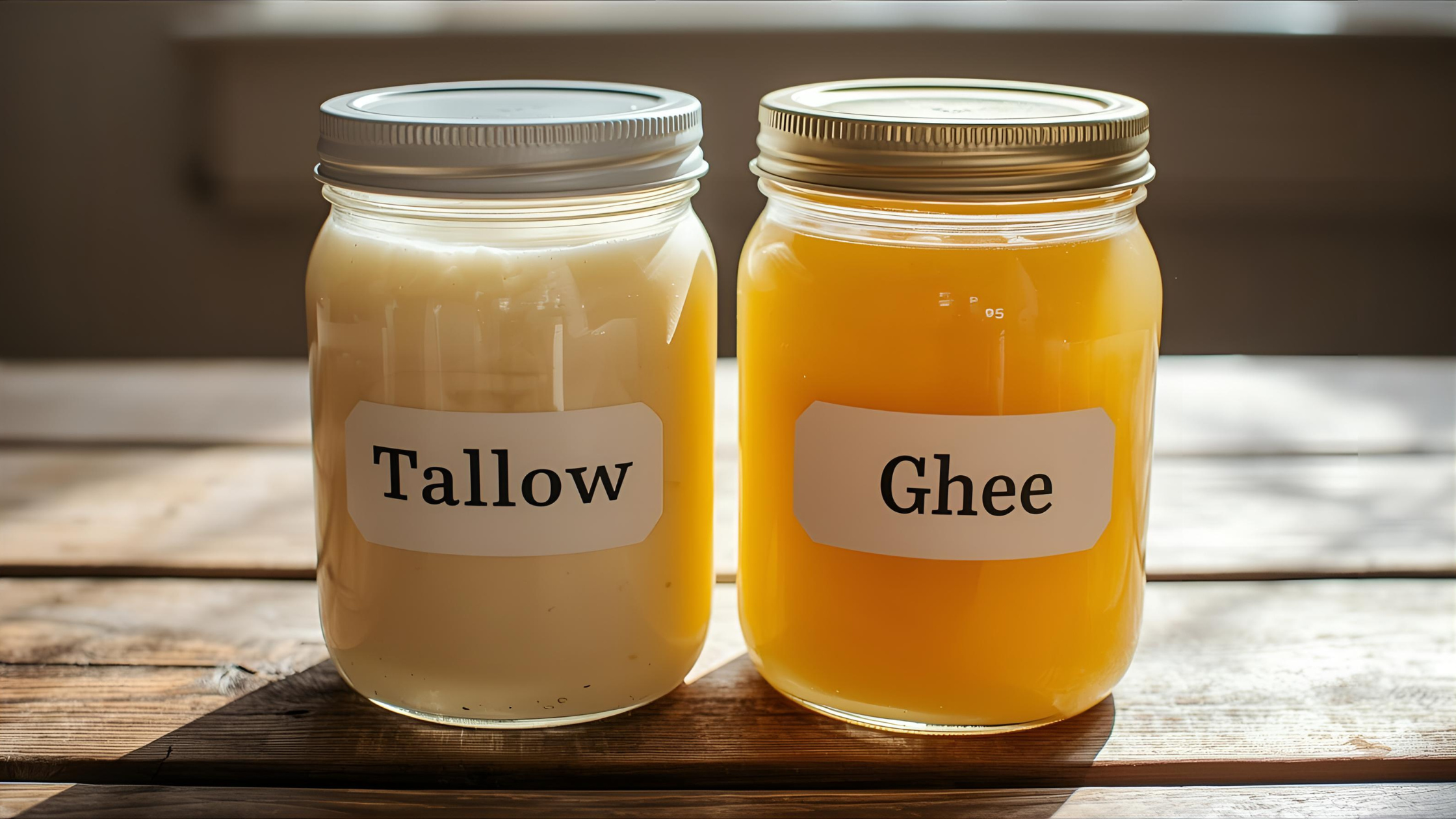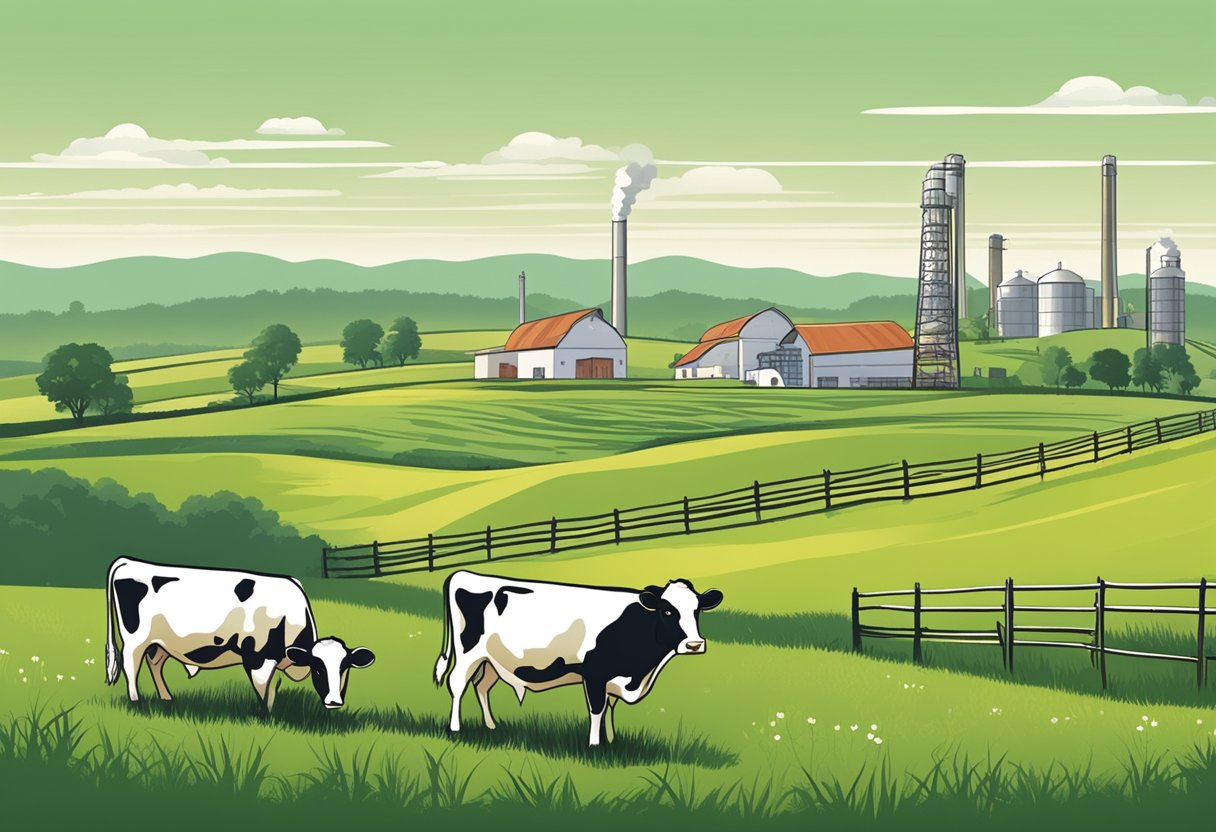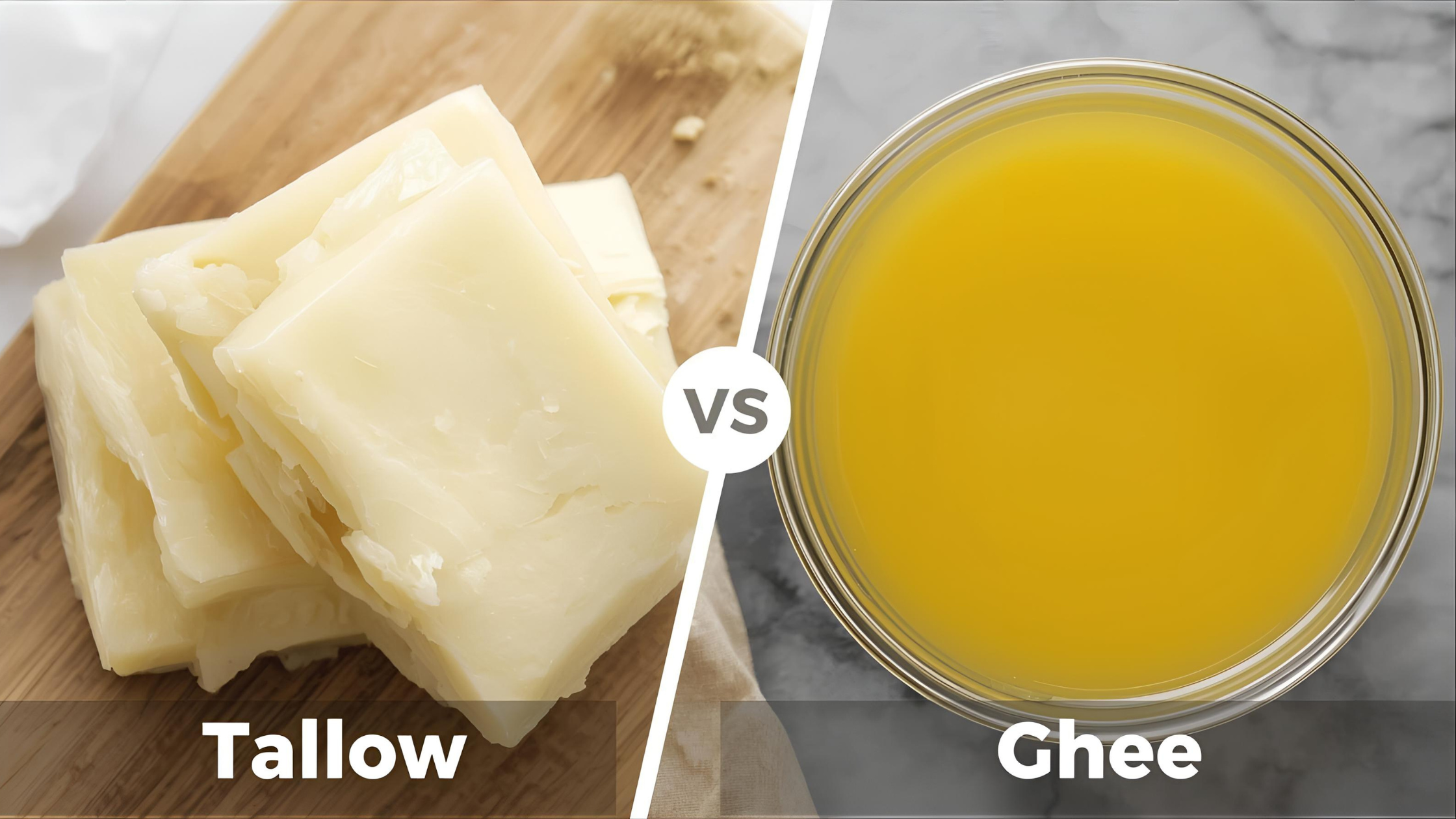Cooking fats can make or break a dish. You’ve likely heard of ghee and tallow, but do you know how they stack up against each other? These two fats have unique qualities that set them apart in the kitchen.
Ghee and tallow are both excellent choices for cooking, but they have different flavour profiles and nutritional benefits. Ghee, made from butter, has a rich, nutty taste. Tallow, rendered from beef fat, offers a subtle beefy flavour. Both can handle high heat cooking, making them versatile options for your culinary adventures.
If you’re worried about dairy sensitivities, tallow might be your go-to. It’s completely dairy-free. Ghee, while mostly lactose-free, may still contain trace amounts. Your dietary preferences and health goals will play a big role in choosing between these two fats.
Key Takeaways
- Ghee and tallow have distinct flavours and can be used for high-heat cooking
- Tallow is dairy-free, while ghee is nearly lactose-free but may contain traces
- Both fats offer unique nutritional benefits and can fit various dietary needs
Understanding Ghee and Tallow
Ghee and tallow are two popular cooking fats with unique qualities. They both come from animal sources but have different uses in the kitchen.
What Is Ghee?
Ghee is a type of clarified butter common in Indian cooking. To make ghee, you heat butter until the water evaporates and milk solids separate. Then you strain out the solids.
The result is a golden, nutty-tasting fat. Ghee has a high smoke point of about 250°C (482°F). This makes it great for high-heat cooking like frying and sautéing.
Ghee is lactose-free, so some people who can’t eat butter can use it. It’s rich in vitamins A, D, E, and K. You can use ghee for:
- Spreading on toast
- Cooking eggs
- Making sauces
- Baking treats
What Is Tallow?
Tallow is a versatile cooking fat made from beef fat. To make it, you slowly heat beef fat until it melts. Then you strain out any bits of meat or gristle.
The result is a white, solid fat at room temperature. Tallow has a beefy flavour that works well in savoury dishes. Its smoke point is about 204°C (400°F).
Tallow is rich in vitamins A, D, E, and K. It also has omega-3 and omega-6 fatty acids. You can use tallow for:
- Deep frying
- Roasting veggies
- Making pastry
- Cooking meats
Both ghee and tallow are healthy fats when used in moderation. They add flavour and richness to your cooking.

Nutritional Composition
Beef tallow and ghee have unique nutritional profiles. They differ in their fatty acid makeup, vitamin content, and overall calorie density. Let’s explore these differences to help you make informed choices for your cooking and dietary needs.
Fatty Acid Profiles
Beef tallow and ghee have different fatty acid compositions. Beef tallow is rich in saturated and monounsaturated fats, similar to those found in olive oil. It contains oleic acid, which can be beneficial for your health.
Ghee, on the other hand, is primarily made up of saturated fats. It also has small amounts of polyunsaturated fats. Both fats contain conjugated linoleic acid (CLA), but beef tallow typically has more.
Here’s a quick comparison:
- Beef Tallow: Higher in monounsaturated fats
- Ghee: Higher in saturated fats
Vitamins and Minerals
Both beef tallow and ghee contain fat-soluble vitamins, but in different amounts. Beef tallow is a good source of vitamins A, D, E, and K. These vitamins play crucial roles in your body, from supporting eye health to helping with calcium absorption.
Ghee also contains these vitamins, but often in smaller quantities. However, ghee is known for its high vitamin K2 content, which is important for bone health.
Mineral-wise, both fats contain trace amounts of calcium and potassium. Ghee might have slightly more, depending on how it’s processed.
Caloric and Fat Content
When it comes to calories, beef tallow and ghee are quite similar. Both are pure fats, so they’re calorie-dense foods. A tablespoon of either will give you about 115-120 calories.
The fat content is where they differ slightly:
- Beef Tallow: About 13g of fat per tablespoon
- Ghee: About 14g of fat per tablespoon
Ghee has a bit more fat because it’s more concentrated than beef tallow. During the ghee-making process, water and milk solids are removed, leaving behind pure butterfat.
Remember, while both are high in calories, they can be part of a healthy diet when used in moderation. Their high smoke points make them great for cooking at high temperatures.
Culinary Applications
Tallow and ghee offer unique qualities in the kitchen. Both fats bring distinct flavours and properties to your cooking. Let’s explore how you can use them in your culinary adventures.
Flavour Contributions
Tallow adds a rich, beefy taste to your dishes. It’s great for enhancing savoury meals. When you use tallow, you’ll notice a depth of flavour in your cooking.
Ghee has a nutty, slightly sweet taste. It’s perfect for both sweet and savoury recipes. You’ll love the buttery aroma it brings to your food.
Try using tallow for roasting veggies. It gives them a lovely flavour. Ghee works well in baked goods, adding a yummy butteriness.
Cooking Methods
Both fats shine in different cooking methods. Tallow is excellent for high-heat cooking. You can use it for frying, roasting, and sautéing.
Ghee also has a high smoke point, making it great for various cooking methods. It’s perfect for stir-frying and deep frying.
Here’s a quick guide:
- Tallow: Great for roasting, frying, sautéing
- Ghee: Ideal for baking, stir-frying, deep frying
Both fats won’t burn easily at high temps. This means you can cook without worry about smoke or bad flavours.
Culinary Versatility
You’ll find tallow and ghee quite versatile in the kitchen. Tallow works well in savoury dishes. Use it to fry chips or roast potatoes for a crispy texture.
Ghee shines in both savoury and sweet recipes. You can use it in curries, on toast, or in baked goods. It’s a great butter substitute in many recipes.
Try these ideas:
- Use tallow to fry eggs for a tasty breakfast
- Spread ghee on your morning toast
- Cook pancakes in ghee for a nutty flavour
- Roast veggies in tallow for a crispy finish
Both fats can replace oil in many recipes. They add flavour and richness to your cooking.
Health and Dietary Considerations When Choosing Tallow vs Ghee
Tallow and ghee offer different health benefits and suit various diets. Your choice between these fats can impact heart health, allergies, and nutritional intake. Let’s explore how they stack up in key areas.
Heart Health and Cholesterol
Beef tallow and ghee both contain saturated fats, which have been a topic of debate in heart health discussions. Beef tallow is rich in conjugated linoleic acid (CLA), a type of fat that may help reduce inflammation and improve heart health.
Ghee, on the other hand, contains higher levels of butyric acid, which might support gut health and indirectly benefit your heart.
Both fats can raise HDL (good) cholesterol levels when consumed in moderation. However, if you’re watching your saturated fat intake, you might want to use these fats sparingly.
Dairy Sensitivities and Allergies
If you’re lactose intolerant or have dairy allergies, your choice between tallow and ghee is clear. Beef tallow is completely dairy-free, making it a safe option for those with milk-related sensitivities.
Ghee is considered lactose-free and casein-free, as these components are removed during processing. However, traces may remain, so if you have severe dairy allergies, tallow might be the safer choice.
For those following a strict dairy-free diet, beef tallow is the obvious winner.
Suitability for Various Diets
Tallow and ghee fit into many popular diets, but their suitability varies:
- Paleo Diet: Both are excellent choices, as they’re minimally processed.
- Keto Diet: High in healthy fats, tallow and ghee are keto-friendly.
- Whole30: Both are compliant, but ghee is often preferred for its flavour.
Tallow might edge out ghee for those following autoimmune protocols due to its dairy-free nature. Ghee, however, offers more versatility in cooking and baking.
Both fats provide nutritional benefits like fat-soluble vitamins. Your choice may ultimately depend on your specific dietary needs and flavour preferences.
Tallow vs Ghee Comparison
Tallow and ghee are both popular cooking fats with unique qualities. They differ in their origins, flavour profiles, and how they perform in the kitchen.
Smoke Point and Cooking Stability
Tallow and ghee have high smoke points, making them great for cooking at high temperatures. Beef tallow’s smoke point is about 400°F, while ghee’s can reach up to 485°F. This means you can use both for frying, sautéing, and roasting without worrying about them breaking down.
Ghee has a slight edge in stability. It’s more resistant to oxidation, so it keeps well at room temperature. Tallow is solid at room temp, which can be handy for certain recipes.
Both fats are mostly saturated, which helps them stay stable during cooking. This means less harmful compounds form when you heat them up.
Flavour and Aroma Differences
Your choice between tallow and ghee can really impact the taste of your dishes. Ghee has a rich, nutty flavour that adds depth to both sweet and savoury foods. It’s especially yummy in baked goods and Indian cuisine.
Tallow, on the other hand, has a distinct beefy taste. It’s fantastic for enhancing the flavour of roasted veggies or giving a meaty boost to fried foods. Some people find its flavour too strong, while others love how it adds richness to dishes.
If you’re after a more neutral taste, ghee might be your best bet. But if you want to embrace that savoury, meaty flavour, tallow is the way to go.
Health Impact
Both tallow and ghee are high in saturated fat, so moderation is key. Ghee might have a slight health edge. It contains vitamins A, D, E, and K, which are good for your body. It’s also free of milk solids, making it a option if you’re lactose intolerant.
Tallow is rich in conjugated linoleic acid (CLA), which some studies suggest might have health benefits. It’s also a good source of vitamin D and E.
Neither fat contains trans fats, which is a plus. Both can be part of a healthy diet when used in moderation. As always, it’s best to chat with your doctor about what’s right for you.
Culinary Flexibility
You’ll find both tallow and ghee are super versatile in the kitchen. Ghee shines in baking, giving pastries a rich, buttery flavour without burning. It’s also great for sautéing veggies or making sauces.
Tallow is a champ for deep frying. It gives foods a crispy texture and doesn’t leave them greasy. It’s also fab for roasting potatoes or making flaky pie crusts.
Both fats work well as spreads or for finishing dishes. Try ghee on your morning toast or tallow to add richness to a steak. They’re also great for seasoning cast iron pans.
Alternative Uses Beyond Cooking
Tallow and ghee offer surprising benefits outside the kitchen. These versatile fats can enhance your beauty routine and support your health in unexpected ways.
Beauty and Skincare
You might be surprised to learn that tallow and ghee make great skin balms and moisturizers. Tallow’s composition is similar to human skin, making it an excellent natural moisturizer. It’s rich in vitamins A, D, E, and K, which can nourish your skin and help maintain its elasticity.
Ghee also works wonders for your skin. Its fatty acids can help hydrate dry skin and reduce inflammation. You can use it as a lip balm or massage it into rough areas like elbows and heels.
Both fats can be ingredients in homemade soaps and lotions. They’re especially helpful for those with sensitive skin or allergies to commercial products.
Medicinal Purposes
In traditional medicine, tallow and ghee have been used for centuries. Ghee plays a big role in Ayurvedic medicine. It’s believed to improve digestion and boost your immune system.
Tallow contains conjugated linoleic acid, which might help reduce inflammation in your body. Some people use it to soothe minor cuts and burns.
Both fats are rich in butyrate, a fatty acid that may support gut health. They also contain antioxidants that could help protect your cells from damage.
Remember to check with your doctor before using these fats for medicinal purposes. While they have potential benefits, they’re not substitutes for professional medical advice.
Cultural and Traditional Significance
Ghee and tallow have deep roots in different culinary traditions. These fats play important roles in various cuisines and cultural practices around the world.
Ghee in Indian Cuisine and Rituals
Ghee holds a special place in Indian cuisine and religious ceremonies. You’ll find it used in many traditional dishes across South Asia. In Hindu rituals, ghee is often used in lamps and offerings.
When cooking, you might use ghee to add a rich, nutty flavour to your curries and dal. It’s also great for making sweets like laddoos and halwa.
Ayurvedic medicine values ghee for its supposed healing properties. Some people believe it can improve digestion and boost immunity.
If you’re keen on trying authentic Indian flavours, look for ghee made from grass-fed butter. It’s said to have a more complex taste that can elevate your culinary adventures.
Tallow in Western Culinary History
Tallow has been a staple in Western cooking for centuries. You might be surprised to learn that it was once the go-to fat for frying in many European and North American kitchens.
In the past, you’d often find tallow used for:
- Making pastry crusts
- Frying fish and chips
- Cooking hearty stews
Tallow candles were also common before electric lighting. Some artisanal candlemakers still use it today.
While less popular now, tallow is making a comeback in some traditional cooking circles. You might enjoy its rich flavour in roasted potatoes or as a spread on crusty bread.
Environmental and Ethical Considerations

When choosing between tallow and ghee, you might want to think about the environment and ethics. Both have different impacts worth considering.
Tallow comes from beef fat. Raising cattle can use a lot of land and water. It also produces greenhouse gases. But ethical tallow production can focus on animal welfare and sustainable practices.
Ghee is made from butter, which comes from dairy cows. Dairy farming has similar environmental concerns to beef production. But it may use less land overall.
For both, look for products from grass-fed animals. These often have better welfare standards and can be more eco-friendly.
Vegetable oils are sometimes seen as more ethical. But they can have their own environmental issues. Palm oil, for example, is linked to deforestation.
Your dietary choices matter too. If you follow a plant-based diet, neither tallow nor ghee fits. But if you eat animal products, both can be part of a balanced diet.
Think about omega-6 fatty acids as well. Tallow and ghee have less than many vegetable oils. This might be good for your health and the planet.
In the end, your values will guide your choice. Look for brands that match your ethics and environmental concerns.
Frequently Asked Questions
Tallow and ghee have distinct properties that affect their use in cooking, health benefits, and other applications. Let’s explore some common questions about these animal fats.
What are the health benefits of using ghee compared to tallow?
Ghee is rich in vitamins A, D, E, and K. It also contains butyric acid, which may help with digestion. Ghee has less lactose than butter, making it a good choice for some people with dairy sensitivities.
Tallow is high in saturated fats and contains vitamin D. It’s a good source of conjugated linoleic acid, which may have anti-inflammatory properties.
Can you use tallow and ghee interchangeably for cooking?
You can often swap tallow and ghee in recipes, but there are differences to keep in mind. Ghee has a higher smoke point than tallow, making it better for high-heat cooking.
Tallow has a meatier flavour, while ghee tastes nuttier. Consider how these flavours will affect your dish when choosing between them.
Which is preferred for skin care, ghee or tallow, and why?
Tallow is often preferred for skin care because its fatty acid profile is similar to human skin. It’s rich in vitamins A, D, E, and K, which can nourish your skin.
Ghee can also be used in skin care. It’s moisturizing and contains vitamin E. However, it may not be as stable or long-lasting on the skin as tallow.
How do the flavours of tallow and ghee differ in culinary applications?
Beef tallow has a subtle meaty taste, which can enhance savoury dishes. It’s great for frying and roasting meats and vegetables.
Ghee offers a nutty, rich butter flavour. It’s delicious in both sweet and savoury recipes, adding depth to baked goods and curries alike.
In terms of nutritional content, how do ghee and tallow compare?
Both ghee and tallow are high in saturated fats. Ghee contains more short-chain fatty acids, which may be easier to digest.
Tallow has more vitamin D than ghee. Ghee is richer in vitamins A and E. Both fats are calorie-dense, so use them in moderation as part of a balanced diet.
When frying foods, which animal fat is considered the best option?
For frying, both tallow and ghee are excellent choices due to their high smoke points. Tallow’s smoke point is around 400°F, while ghee’s is even higher.
Tallow is often preferred for deep frying because of its neutral flavour and lower cost. Ghee can add a rich, buttery taste to fried foods but may be more expensive.
